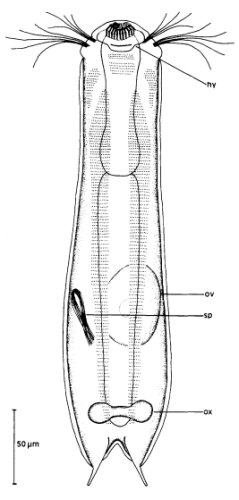Arenotus strixinoi

271 µm - 336 µm
Width:
Width of the head ( five-lobed ):
µm
Length of the furca:
30 µm
Adhessive tubes:
30% of furca
Pharyx ( dumbbell-shaped ):
82 µm - 130 µm
Diameter of the mouth ( elliptical, two teeth (9x5 µm) ):
8 x 20 µm
Dorsal scales:
no scales, but closed cuticular layer
Ventral scales:
broad hypostomium with transverse furrow (38-42 µm); two rows of cilia; additionally two ciliary tufts on head (median), one pair of ciliary tufts laterally on head
Oecology:
Psammon (sandy ground)
Similar species:
Similar to Ichthydium, but completely covered with structureless cuticle (in Ichthydium the cuticle is usually finely structured); well demarcated by complex structure of mouth.
Particularities:
soft cuticular layer; teeth